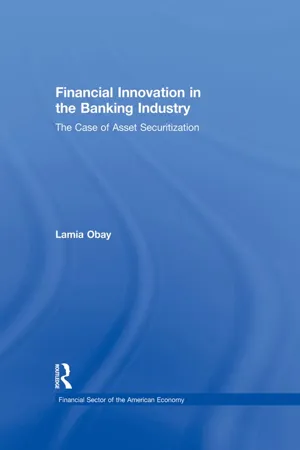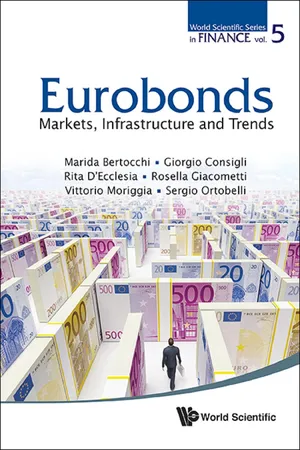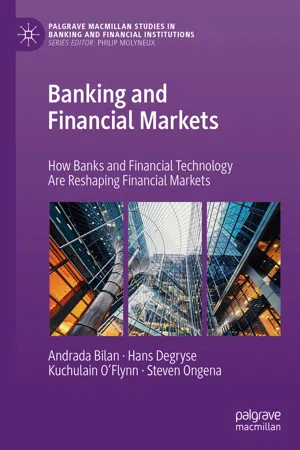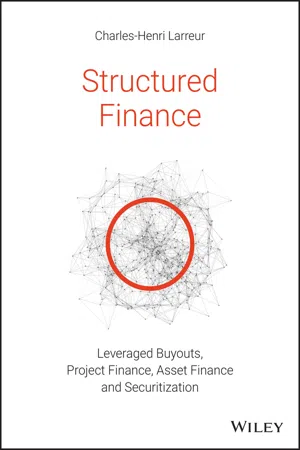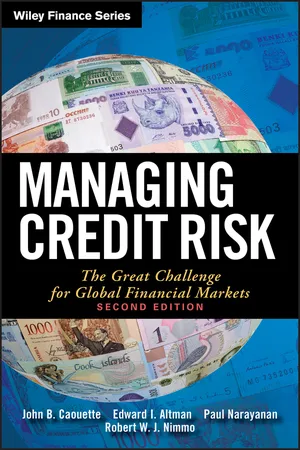Economics
Securitization
Securitization is the process of pooling various types of debt, such as mortgages or loans, and transforming them into tradable financial instruments. These instruments, known as securities, are then sold to investors. By securitizing debt, financial institutions can free up capital and reduce risk, while investors gain access to a diverse range of investment opportunities.
Written by Perlego with AI-assistance
Related key terms
Related key terms
1 of 4
Related key terms
1 of 3
11 Key excerpts on "Securitization"
- eBook - ePub
Financial Innovation in the Banking Industry
The Case of Asset Securitization
- Lamia Obay(Author)
- 2014(Publication Date)
- Routledge(Publisher)
All of these transactions are types of Securitization. In its broadest sense, Securitization is financial intermediation that involves at some stage the buying and selling of financial claims. Indeed, “perhaps the best definition of Securitization is the matching up of borrowers and savers wholly or partly by way of the financial markets.… Such a definition covers issuance of securities such as bonds and commercial papers—a practice that entirely replaces traditional financial intermediation—and also sales of mortgage-backed and other asset-backed securities—transactions that rely on financial intermediaries to originate loans but use the financial markets to seek the final holders” (Cumming, 1987, p.11, 12.) This definition is broad enough to include the sale of loan participations among banks or packages of commercial mortgages among thrifts, and yet excludes not only traditional bank lending but also similar activities at finance and insurance companies.A narrower definition refers to the pooling and repackaging of loans or generally illiquid assets of banks, thrifts, and other intermediaries for sale in securities forms in the financial market (BIS, 1986; Cumming, 1987; Pavel, 1989; Federal Reserve Board, 1989; Bryan, 1989; Borkowski, 1991 ; and Kavanagh, 1992). As such, asset (or credit) Securitization is simply a “subset of a broader trend seen throughout the capital markets for many years, ‘Securitization’, that is, the general phenomenon whereby more and more fund raising is occurring through the agency of securities.” (Rosenthal and Ocampo, 1988, p.3)While the selling of whole loans dates back to the 1880 (Pavel, 1989), Securitization is a recent innovations in loan sales. Like whole loan sales and participations, Securitization provides an additional funding source and may eliminate the assets form the originator's balance sheet. Unlike whole loan sales and participations, Securitization is often used to market loans that would be difficult to sell on a stand-alone basis. - eBook - ePub
The Mechanics of Securitization
A Practical Guide to Structuring and Closing Asset-Backed Security Transactions
- Suleman Baig, Moorad Choudhry(Authors)
- 2013(Publication Date)
- Wiley(Publisher)
Instruments are available backed by a variety of assets covering the entire yield curve, with either fixed or floating coupons. In the United Kingdom, for example, it is common for mortgage-backed bonds to have floating coupons, mirroring the interest basis of the country's mortgages. To suit investor requirements, however, some of these structures have been modified, through swap arrangements, to pay fixed coupons.The market in structured finance securities was hit hard in the wake of the 2007–2008 financial crisis. Investors shunned asset-backed securities in a mass flight to quality. As the global economy recovered from recession, interest in Securitization resumed. We examine the fallout in the market later in this chapter. First we discuss the principal concepts that drive the desire to undertake Securitization.The Concept of Securitization
Securitization is a well-established practice in the global debt capital markets. It refers to the sale of assets, which generate cash flows, from the institution that owns them, to another company that has been specifically set up for the purpose, and the issuing of notes by this second company. These notes are backed by the cash flows from the original assets. The technique was introduced first as a means of funding for mortgage banks in the United States, with the first such transaction generally recognized as having been undertaken by Salomon Brothers in 1979. Subsequently, the technique was applied to other assets such as credit card payments and leasing receivables, and has been employed worldwide. It has also been employed as part of asset-liability management, as a means of managing balance sheet risk.Reasons for Undertaking Securitization
The driving force behind Securitization has been the need for banks to realize value from the assets on their balance sheet. Typically these assets are residential mortgages, corporate loans, and retail loans such as credit card debt. The following are factors that might lead a financial institution to securitize a part of its balance sheet: - eBook - ePub
Euro Bonds: Markets, Infrastructure And Trends
Markets, Infrastructure and Trends
- Marida Bertocchi, Giorgio Consigli, Rita D'Ecclesia, Rosella Giacometti, Vittorio Moriggia, Sergio Ortobelli(Authors)
- 2013(Publication Date)
- WSPC(Publisher)
Chapter 6Securitization Market(Rosella Giacometti)6.1 IntroductionSecuritization — the process by which an asset is transformed into a security i.e. a capital market instrument — has been one of the most innovative developments in financial markets in the last two decades. Securitization is the financial practice of pooling various types of contractual debt such as residential mortgages, commercial mortgages, auto loans or credit card debt obligations and selling the consolidated debt to various investors.Securities backed by mortgage receivables are called Mortgage Backed Securities (MBS), by bonds are called Collateralized Debt Obligations (CDO) while those backed by other types of receivables are broadly grouped as other Asset Backed Securities (ABS).Securitization has evolved from the late 1970s, when ‘Ginnie Mae’ — a government sponsored entity — sold its first MBS, to an estimated outstanding volumes of €6,685 billion in the United States and €1,959 billion in Europe as of the 4-th quarter of 2011. In 2011, ABS issuance amounted to €1,014 billion in the US and €372 billion in Europe.One of the principal characteristics required for assets to be securitized is that they can be decomposed into a series of cash flows or ‘receivables’, which can then be packaged and re-packaged with other cash flows. In other words, Securitization is a process by which the Originator identifies the claims that it would like to transfer to the market. Banks and private organisations have incomes that are due to them in the future in payment for loans or services that they have offered to third parties. By making these debt instruments available to the capital markets in a format they can easily handle, the Originators transform assets into liquid tradable securities. By pooling and repackaging these illiquid assets the Originators transform them into marketable securities. The motivation is to raise funds and transfer the risk of the underlying portfolio of assets to other investors. The funds raised can then be used for some other productive purpose. - eBook - ePub
Banking and Financial Markets
How Banks and Financial Technology Are Reshaping Financial Markets
- Andrada Bilan, Hans Degryse, Kuchulain O’Flynn, Steven Ongena(Authors)
- 2019(Publication Date)
- Palgrave Macmillan(Publisher)
© The Author(s) 2019 A. Bilan et al. Banking and Financial Markets Palgrave Macmillan Studies in Banking and Financial Institutions https://doi.org/10.1007/978-3-030-26844-2_2Begin Abstract2. Securitization and Lending
Andrada Bilan1,Hans Degryse2,Kuchulain O’Flynn1andSteven Ongena1(1) Department of Banking and Finance, University of Zurich, Zürich, Switzerland(2) Faculty of Economics and Business, Katholieke University of Leuven, Leuven, BelgiumEnd AbstractKeywords
Banks Lending Securitization Information frictions Monetary policy Bank regulation Global financial crisisWhile Securitization dates back to the seventeenth and the eighteenth century in Holland (Goetzmann and Rouwenhorst 2008 ), its massive usage is a relatively recent development in credit markets. Securitization implies that financial intermediaries that grant illiquid loans subsequently pool them together, diversifying risks and converting the loans into liquid assets or asset-backed securities (ABSs). These assets are then sold to outside investors, in exchange for wholesale funding. While the largest share of asset-backed securities cover individual mortgage loans, other types of loans can also be securitized (including automobile credit, student loans, or corporate loans).At the end of 2007, the US-securitized mortgage loan market reached $6.42 trillion (Loutskina 2011 ). A liquid market for securitized assets has recognized benefits for credit markets, such as improving risk-sharing and reducing banks’ cost of capital (Pennacchi 1988 ). Credit to both households and firms should grow as a result. However, the global financial crisis of 2007-2009 uncovered ways in which the process of Securitization could also hurt lending. It is well understood that the crisis started in the securitized subprime loan market, which collapsed after having accumulated unmanageable amounts of risks. This prompted both researchers in finance and policymakers to seek a better understanding of the benefits but also the vulnerabilities of the markets for asset-backed securities. Below, we review some of the recent empirical literature addressing this need. As with the remaining chapters, we first review the main data sources used by empirical researchers studying Securitization and then we discuss the most common methodologies employed, before presenting selected contributions. Table 2.1 offers a compact overview of the papers reviewed.Table 2.1 Securitization and lendingPaperResearch questionDataMethodologyMain findingsLoutskina (JFE, 2011 )Does Securitization change bank liquidity management?Bank financial statements extracted from the Federal Reserve call reports in a long-term panel (1976 to 2007) Correlations: between the intensity of Securitization and bank on-balance sheet liquidity indicators. Enhances with difference-in-differences specifications around regulatory interventionsFrom 1976 to 2007, as banks’ ability to securitize loans has increased, the percentage of total assets held as liquid securities decreased on average by 7.33 percentage points - eBook - ePub
Lessons from the Financial Crisis
Causes, Consequences, and Our Economic Future
- Rob Quail, Robert W. Kolb(Authors)
- 2010(Publication Date)
- Wiley(Publisher)
This is a classic principal-agent problem that arises whereby the incentives of the originator of credit are not aligned with those of the entity that ultimately holds the loan. 3. Third, the credits are securitized in pools with new securities that have claims on the pooled cash flows. This means that these new securities do not have a direct claim on any specific loan or credit. This complexity makes it difficult to sort out the claims in the event of a specific credit default. WHAT IS Securitization? Securitization is a form of asset-backed finance that involves the pooling of a set of credits or debt securities whose acquisition is financed by the issuance of new debt securities. The new securities go by various names, depending on the type of assets in the pool. For example, if the pooled assets consist of residential home mortgages, then the new securities are residential mortgage-backed securities (RMBS); if the pooled assets consist of business loans, then the new securities are known as collateralized loan obligations (CLO); and so forth. The payments of principal and interest on the securities issued in the Securitization are derived from the cash flows generated by pools of assets. Both consumer debt and corporate debt have been securitized. Consumer credit is divided into mortgage loans and all other types of consumer debt. For example, when residential mortgages are securitized, the entity that performs the Securitization issues residential mortgage-backed securities (RMBS). When credit card debt or other forms of consumer debt are securitized, the securities issued against these pools are referred to simply as asset-backed securities (ABS). The term collateralized debt obligation (CDO) is sometimes used as the broad umbrella term to refer to all types of securities issued in Securitizations involving corporate debt - eBook - ePub
Securitization in India
Managing Capital Constraints and Creating Liquidity to Fund Infrastructure Assets
- Jennifer Romero-Torres, Sameer Bhatia, Sural Sudip(Authors)
- 2017(Publication Date)
- Asian Development Bank(Publisher)
The Securitization Market in IndiaA. Securitization Structures in India
Securitization is the process of converting illiquid loans into marketable securities. The lender sells his or her right to receive future payments from the borrowers to a third party, and is paid for it. The lender is therefore repaid at the time of Securitization. These future cash flows from the borrowers are sold to investors in the form of marketable securities.Figure 7: How Securitization Works Source: CRISIL.Securitization in India mainly takes the form of a trust structure, wherein the underlying assets are sold to a trustee company, which holds the security in trust for investors. The trustee company in this case is a special-purpose vehicle (SPV), which issues securities in the form of pass-through or pay-through certificates (PTCs). The trustee is the legal owner of the underlying assets. Investors holding the PTCs are entitled to beneficial interest in the underlying assets held by the trustee (Figure 8 ).Figure 8 : Securitization Structure in IndiaSource: CRISIL. The parties involved in the Securitization process and their respective roles are stated briefly below.(i) Originator . The original lender and seller of receivables. In India, this is typically a bank, an NBFC, or a housing finance company. (ii) Seller . One who pools the assets to securitize them. In India, the seller and the originator are usually the same entity. (iii) Borrower . The counterparty to whom the originator makes a loan. Payments (typically in the form of equated monthly installments) by borrowers fund investor payouts. (iv) Issuer (SPV) . The entity that issues marketable securities (to which investors subscribe) and ensures that transactions are executed on specific terms. In India, the SPV is typically set up as a trust. (v) Arranger - eBook - ePub
Structured Finance
Leveraged Buyouts, Project Finance, Asset Finance and Securitization
- Charles-Henri Larreur(Author)
- 2021(Publication Date)
- Wiley(Publisher)
Even if the borrowers rarely (or never) realize that their future payments are transferred to an SPV, Securitization is paradoxically of importance for them. From a macroeconomic point of view, Securitization increases the available credit supply. In the same way that the bond market provides companies with an alternative to bank loans, Securitization brings another set of solutions to finance or refinance individuals, households, businesses, LBOs, etc. It creates a new pool of liquidity in addition to traditional tools.Securitization is for this reason an integral part of the financial disintermediation process that we already discussed several times in this book, notably in case study 2 on Michael Milken. Securitization is a major driver of the change in the way the economy is financed. Whereas in the traditional economic model companies and individuals were only financed by banks, they can now be financed directly by a wide range of players (banks, pension funds, insurances companies, asset managers, etc.) through a large variety of instruments (loans, bonds, securities, etc.). The recourse to banks is today just one option amongst others.Given the increasing regulatory constraints imposed on banks, Securitization represents a solid alternative to traditional financing routes. All things being equal, regulation indeed limits the supply of bank loans available to finance the economy. Insofar as regulation demands that banks partly finance their loans by an increasing amount of capital,1 banks have to be more disciplined in the way they use their balance sheet. This leaves room for investors who do not have the same regulatory constraints: pension funds, hedge funds, private equity firms, etc.11.2 THE ORIGINATOR
The originator is the legal entity that originally owns the income‐generating assets that are sold to the SPV (see Figure 11.2 - eBook - ePub
Regulating Securitized Products
A Post Crisis Guide
- R. Saleuddin(Author)
- 2015(Publication Date)
- Palgrave Macmillan(Publisher)
1 Introduction: Securitization as Villain and SaviorBefore 2007, I wager that very few academics, policy makers or indeed few outside a small coterie of specialists had any idea how important Securitization was to the growth in the financial economy during this millennium.1 By now, however, it has been well established that the practice of transferring some or all of the risks of some financial products from the originator (a mortgage lender, for example) to end investors played a significant destabilizing role during the Global Financial Crisis (GFC), and may have even been a primary cause of the worst economic turmoil since the Great Depression.2As has been well, though not always accurately, documented in the press and – more recently – the academic literature, legislative and industry reaction to the GFC has generated many new regulations, regulatory agencies and governmental powers. There can be no doubt that some progress has been made in making the financial system more robust in the face of any GFC-like recurrence. For example, liquidity lines to the most highly levered vehicles during the GFC are now much more capital intensive and, therefore, discourage such leverage. Chapter 3 covers the broader changes, the elements of the new regime that indirectly affect the markets for Securitization, as well as those specifically dealing with Securitization. More changes to this larger regulatory regime for financial markets are still to come. On the other hand, there are still significant controversies to be addressed, with a notable example being the debate between the effectiveness of ‘simple’ versus ‘complex’ regulatory regimes and rules.3 - eBook - ePub
The Economist Guide To Financial Markets 7th Edition
Why they exist and how they work
- Marc Levinson(Author)
- 2018(Publication Date)
- Economist Books(Publisher)
Securitisation involves transforming, or packaging, such assets into securities that can be sold to third parties. Securitisation is accomplished with the help of an investment bank, which sets up a trust whose sole purpose is to own the assets being securitised. Usually, each trust is created to own a pool composed of a single type of asset, such as $100m of automotive loans. The trust will purchase the assets in the pool from the firm that created them, using money raised by the sale of asset-backed securities to investors. The owners of the securities are entitled to receive whatever income the assets generate, and in most cases to a pro-rata share of the assets themselves. When individual assets owned by the trust are retired – for example, when an individual loan is paid off – the size of the trust diminishes. Eventually, all the assets will be retired, at which point the trust will terminate.In general, the diversity of the assets underlying an asset-backed security provides safety to investors. However, some lenders may attempt to securitise a large proportion of the loans they originate and hold onto few of them, giving them little incentive to make sure that the individual loans are sound. The securitisation of unsound loans was a major contributor to the financial crisis that began in 2007, and caused large losses to both investors and the banks that originated the securities. As a result of these problems, financial regulators in many countries have required banks to maintain ownership of a significant portion of the loans that they bundle into securities and to hold capital – shareholders’ funds – to protect against a decline in value of the portion they own. These new regulations have made securitisation more costly and therefore less attractive.Recourse to guarantees
In many cases, investors in an asset-backed trust benefit from certain guarantees. Governments frequently guarantee part or all of the payment on residential mortgages to encourage housing construction. The original lender may also guarantee loan payments to induce investors to buy its assets. In this situation, the lender sells the assets to the trust with recourse, meaning that the trust will seek reimbursement from the lender if an individual borrower should fail to pay interest or principal as scheduled. - eBook - ePub
Handbook of the Economics of Finance
Corporate Finance
- George M. Constantinides, Milton Harris, Rene M. Stulz(Authors)
- 2013(Publication Date)
- North Holland(Publisher)
Gorton and Metrick (2010b) propose the creation of “Narrow-Funding Banks” as a mechanism for the regulation of Securitization. Under their proposal, these limited-purpose institutions would be the only legal conduits for Securitization, and their chartering and oversight would provide regulators with the ability to exercise some control over this part of the shadow banking system. The main use of oversight would be to give regulators a direct look into a formally dark part of the financial system, and the main use of control would be to monitor tranches of Securitization so as to minimize regulatory arbitrage.9 Final Comments and Open Questions
Surprisingly, given the importance of Securitization, the most basic questions remain open questions. Studying Securitization offers an opportunity to examine some basic issues in financial economics and macroeconomics. In this final section we try to spell out some of these issues, and offer some speculations and hypotheses about them.Some open questions are:1. Why did Securitization arise? Was there innovation? What are the sources of value? These seem like the most basic and pressing questions. Policy recommendations concerning the future of Securitization depend on the answers to these questions. They also strike at the heart of the process of financial innovation. How and why does innovation occur? Further, the view that financial intermediation is most importantly about the creation of bank loans which have to be held on balance sheet until maturity is inconsistent with selling the loans. But, banks still make the credit decision and hold the residual. Is that sufficient for incentive compatibility?2. The tranching of pools sold to SPVs remains a puzzle. Securitization is about the creation of mostly low-risk debt. The debt issued by a Securitization SPV has no tax advantages and there are no expected bankruptcy costs associated with ABS. From the point of view of Modigliani and Miller, no particular capital structure for the SPV would be predicted. However, Securitization appears to maximize the amount of AAA/Aaa debt that is created. What is the violation of M&M? Is debt optimal because of privately-informed sponsors or is it because there is a demand for high-quality collateral? - eBook - ePub
Managing Credit Risk
The Great Challenge for Global Financial Markets
- John B. Caouette, Edward I. Altman, Paul Narayanan, Robert Nimmo(Authors)
- 2011(Publication Date)
- Wiley(Publisher)
In other parts of the world, there are examples of similarly structured financings in which commercial banks, financial guarantors, and other capital market participants play a role. Examples include several toll road projects in Chile, a Peruvian power plant, gas liquefaction projects in Qatar, and airports in Chile and Australia amongst others. For many of these deals, the object was to gain access to the U.S. 144A market that required, among other things, that the bonds be rated investment grade. Often this was made possible by a surety bond from a financial guarantor.By means of asset-based financings, Securitization, financings based on future revenues, and other innovations, the capital markets have been able to bear credit risk that was hitherto borne mainly by commercial banks and government entities such as states, municipalities, and sovereigns.PERILS OF SecuritizationAlthough Securitization has helped to transform the capital markets and has done much to restore luster to the banking industry, it has a dark side that has emerged as a major challenge in 2007. Securitization technology is sophisticated and relies on advanced mathematical techniques and modeling skills. However, the technology of Securitization is still being proven and frequently relies on a wide variety of assumptions that are “estimates” because the information required for the model or mathematical formula cannot be known or calculated with precision. This means that Securitization technology is particularly vulnerable to the limitations of “garbage in, garbage out.” This appears to be one of those things that happened to the Securitization markets in the subprime crises of 2007. The ensuing crisis has focused us once again on the issues of competence, model risk, liquidity, and integrity. In particular, integrity seems to have broken down as many investment banks, especially Merrill Lynch, were like hogs at the trough. These investment banks controlled originators such a mortgage companies whose loans they packaged and sold into the capital market with a questionable attention to their consequences and possible conflicts of interest embodied in the securities. In addition to the breakdown in common sense on Wall Street, the subprime crisis seems to have involved massive fraud on the part of speculators and some mortgage bankers in this overheated marketplace.
Index pages curate the most relevant extracts from our library of academic textbooks. They’ve been created using an in-house natural language model (NLM), each adding context and meaning to key research topics.
Explore more topic indexes
Explore more topic indexes
1 of 6
Explore more topic indexes
1 of 4
